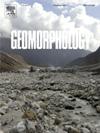里拉和皮林山脉(保加利亚)的马戏形态测定学
IF 3.1
2区 地球科学
Q2 GEOGRAPHY, PHYSICAL
引用次数: 0
摘要
本研究基于保加利亚Rila和Pirin山脉的数字地形模型对马戏团进行了形态计量学分析,解决了巴尔干半岛东北部的研究空白。圆圈是过去冰川作用的关键指标,受基岩、地形和(古)气候的影响,形状和大小差别很大。除了经典的马戏特征外,本研究还利用了额外的形态测量参数,包括马戏的体积、深度和简单的基于坡度的分类。分析的重点是比较两座山,这两座山海拔相似,但地质和山脊方向不同。结果表明,马戏团的规模参数服从对数正态分布。进一步,研究人员探索了两个山脉的旋流场之间的形态差异,其中Rila旋流场通常较浅,发育程度较低,可能是由于存在广泛的平坦表面。相比之下,皮林马戏团,尤其是那些在大理石基岩上形成的,切割得更厉害。气旋的纬向分布呈现出明显的集中,Pirin向东北方向,Rila向北方向,这可归因于两个区域的主脊分别向北西-东南和西-东走向。里拉和皮林马戏团的地板高度是巴尔干半岛最高的。研究表明,该地区马戏的发展受到大陆性气候、有限降水和盛行的西风影响降雪的综合影响。这些发现有助于了解巴尔干地区的冰川动力学,强调了先前存在的地形和气候条件在形成冰川地貌方面的作用。本文章由计算机程序翻译,如有差异,请以英文原文为准。

Cirque morphometry of Rila and Pirin Mountains (Bulgaria)
This study presents a morphometric analysis of cirques based on digital terrain models in the Rila and Pirin Mountains of Bulgaria, addressing a research gap for the northeastern Balkan Peninsula. Cirques, key indicators of past glaciation, vary widely in shape and size, influenced by bedrock, topography and (paleo)climate. Beside classical cirque characteristics this study utilises additional morphometric parameters, including cirque volume, depth and a simple slope-based categorization. The analysis focuses on comparing the two mountains, which share similar elevations but differ in geology and ridge orientations. Results indicate that cirque size parameters follow a lognormal distribution. Further on, morphological differences between the cirques of the two ranges are explored, with the Rila cirques generally being shallower and less developed, likely due to the presence of extensive planation surfaces. In contrast, the Pirin cirques, particularly those formed on marble bedrock, are more incised. The aspect distribution of cirques shows a clear concentration, in the case of Pirin towards the NE, in the case of Rila towards the N, which can be attributed to the NW-SE and W-E strike of the main ridges in the two ranges, respectively. The cirque floor elevation of the Rila and Pirin cirques is among the highest in the Balkans. The research suggests that cirque development in this region was influenced by a combination of continental climate, limited precipitation, and prevailing westerly winds that influenced snow accumulation. The findings contribute to the understanding of glaciation dynamics in the Balkans, emphasizing the role of pre-existing topography and climatic conditions in shaping glacial landforms.
求助全文
通过发布文献求助,成功后即可免费获取论文全文。
去求助
来源期刊

Geomorphology
地学-地球科学综合
CiteScore
8.00
自引率
10.30%
发文量
309
审稿时长
3.4 months
期刊介绍:
Our journal''s scope includes geomorphic themes of: tectonics and regional structure; glacial processes and landforms; fluvial sequences, Quaternary environmental change and dating; fluvial processes and landforms; mass movement, slopes and periglacial processes; hillslopes and soil erosion; weathering, karst and soils; aeolian processes and landforms, coastal dunes and arid environments; coastal and marine processes, estuaries and lakes; modelling, theoretical and quantitative geomorphology; DEM, GIS and remote sensing methods and applications; hazards, applied and planetary geomorphology; and volcanics.
 求助内容:
求助内容: 应助结果提醒方式:
应助结果提醒方式:


